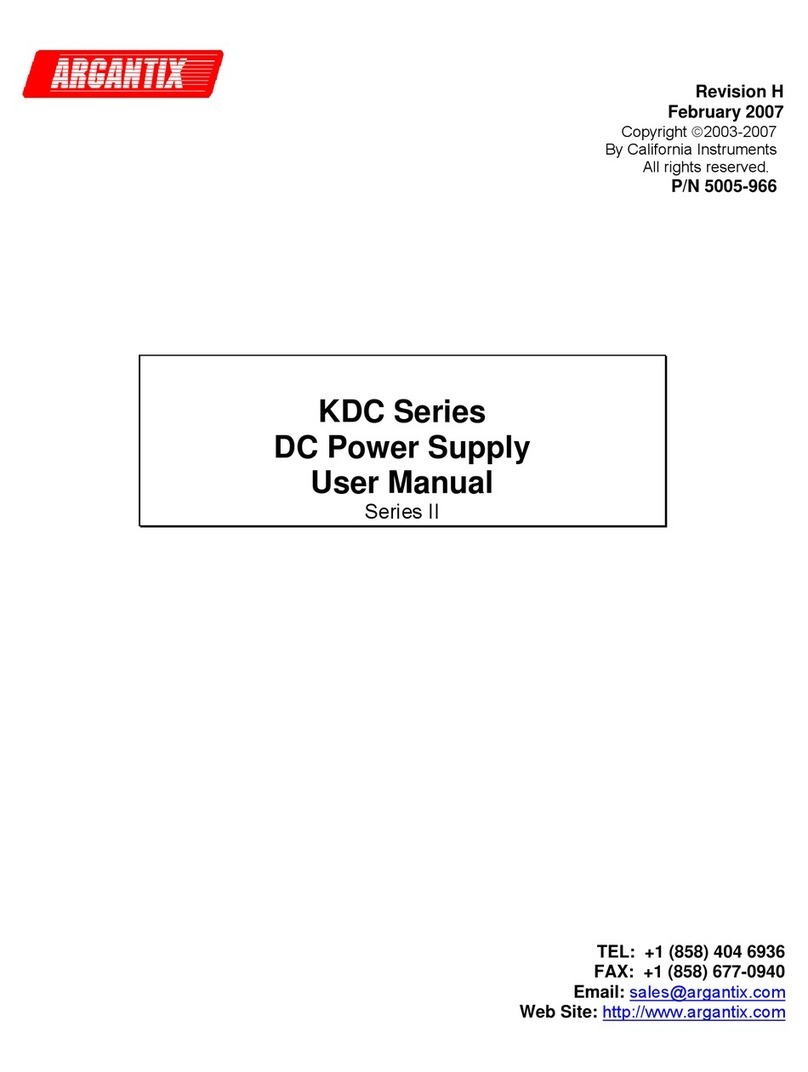
User Manual
vi KDC Series II DC Power Supplies
List of Figures
Figure 1-1: KDC Series DC Power Supply............................................................................................................1
Figure 3-1: Location of rear panel connectors ....................................................................................................16
Figure 3-2: DC Output bus bar studs.................................................................................................................. 17
Figure 3-4: Toroid Installation, -400V input model.............................................................................................. 18
Figure 3-5: Outline Drawing Chassis Dimensions (Shown with safety covers)...................................................19
Figure 4-1: Front Panel View ..............................................................................................................................21
Figure 4-2: Shuttle Knobs ...................................................................................................................................22
Figure 4-3: Front panel layout.............................................................................................................................23
Figure 4-4: Keypad layout...................................................................................................................................24
Figure 4-5: Display and Shuttle Knobs interaction.............................................................................................. 25
Figure 4-6: Sample Transient Output Sequence ................................................................................................ 52
Figure 4-7: Constant Power Mode Profile........................................................................................................... 55
Figure 4-8: Remote Sensing Operation at the Load ...........................................................................................56
Figure 4-9: Remote On / Off Control by Contact Closure ...................................................................................57
Figure 4-10: Remote On / Off Using Isolated TTL/CMOS Voltage Supply..........................................................57
Figure 5-1: Remote Voltage Programming Using 0-5 or 0-10 VDC Source........................................................58
Figure 5-2: Remove Voltage Programming Using Resistance ........................................................................... 59
Figure 5-3: Remote Voltage Programming Using a Current Source...................................................................59
Figure 5-4: Remote Current Programming Using 0-5 or 0-10 VDC Source........................................................ 60
Figure 5-5: Remote Current Programming Using Resistance ............................................................................ 61
Figure 5-6: Remote Current Programming Using a Current Source...................................................................61
Figure 5-7: Parallel Cable Interconnect Accessory.............................................................................................63
Figure 5-8: Auto-Parallel Operation –2 KDC units.............................................................................................66
Figure 5-9: Auto-Parallel Operation –3 KDC units.............................................................................................67
Figure 5-10: Auto-Series Operation.................................................................................................................... 68
Figure 5-11: Auto Tracking Operation.................................................................................................................69
Figure 6-1: DC Power Supply Block Diagram.....................................................................................................73
Figure 6-2: DC Power Supply Block Diagram with -IF option .............................................................................74
Figure 6-3: KDC with -IF option, Simplified Block Diagram................................................................................. 75
Figure 6-4: DC Module Block Diagram ...............................................................................................................77
Figure 7-1: Test Equipment Hookup for Routine Output and Measurement Calibration.....................................83
Figure 8-1: Assembly Location ...........................................................................................................................94
Figure 8-2: Replaceable Fuse Locations .......................................................................................................... 101
Figure 9-1: KDCGUI Main screen .....................................................................................................................102
Figure 9-2: Rear Panel View.............................................................................................................................105
Figure 11-1: OPTIONS screen.......................................................................................................................... 109
Figure 11-2: Available options ..........................................................................................................................109
Figure 11-3: APPLICATIONS Screen............................................................................................................... 112
Figure 11-4: MIL704 Menu................................................................................................................................112
Figure 11-5: MIL704 DC Menu - 1 of 3 .............................................................................................................113
Figure 11-6: MIL704 DC Menu - 2 of 3 .............................................................................................................113
Figure 11-7: MIL704 DC Menu - 3 of 3 .............................................................................................................113
Figure 11-8: Steady State DC........................................................................................................................... 113
Figure 11-9: Transient Menu.............................................................................................................................114
Figure 11-10: Abnormal Test Screen................................................................................................................115
Figure 11-11: Emergency Test .........................................................................................................................116





























